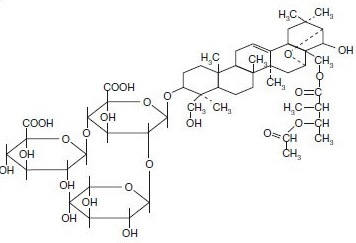SPECTROPHOTOMETRIC DETERMINATION OF THE SUM OF SAPONINS IN THE FRUIT OF THE CHINESE TREE LYCIUM CHINENSE MILL.
UDC 615.322:543.422.3
Abstract
The objects of the study were Mature dried fruits of Chinese birch (Lycium chinense Mill., this. Solanaceae (Solanaceae)). Four samples were examined: no. 1 (Gifts of Pamir, Russia), no. 2 (Gullin Tianhe Pharmaceutical, China), no. 3 (A. J. Alliance, Russia), №. 4 (Globaltorg, Russia). The purpose of this work is to determine the content of the sum of saponins in Chinese fruit trees by spectrophotometry.
By direct spectrophotometry, after reaction with concentrated sulfuric acid, the content of the sum of saponins in the raw material of Chinese wood was determined. The expediency of using the spectrophotometric method for quantitative determination of saponins in extracts from the fruit of Chinese wood is proved. The values of the optical density of the saponin solution were recorded at a wavelength of 250-500 nm. Analytical maxima of the studied compounds were determined at 325 nm typical for escin. Optimal conditions for the extraction of saponins from the raw materials of this plant (extractant – 40% ethanol; the ratio "raw material – extractant" – 1 : 50; extraction time – 90 minutes; the degree of grinding of raw materials – 0.5 mm) are justified. It was determined that the error of a single determination of the saponin content in Chinese fruit with a confidence probability of 95% is ±1.93%. It was found that the content of saponins in the studied samples of Chinese wood varies in the range of 4.94 to 5.03%.
Downloads
Metrics
References
Semenova Ye.F., Apenkina T.V., Azizova L.M., Kurdyukov Ye.Ye., Begutova Ye.V. Izvestiya vysshikh uchebnykh zavedeniy. Povolzhskiy region. Yestestvennyye nauki, 2015, no. 4 (12), pp. 68–76. (in Russ.).
Nikolayeva Yu. Yagody Godzhi. Plody dolgoletiya i superzdorov'ya. [Goji berries. The fruits of longevity and super health]. Moscow, 2015, 128 p. (in Russ.).
Yevtukhova L.A., Gorbunov A.B., Kukushkina T.A. Izvestiya Gomel'-skogo gos. un-ta im. F. Skoriny, 2007, no. 6(45), pp. 33–36. (in Russ.).
Fedoseyeva L.M., Bashar D.B. Khimiya rastitel'nogo syr'ya, 2016, no. 1, pp. 181–184. (in Russ.).
Petukhova S.A., Olennikov D.N., Mirovich V.M. Khimiya rastitel'nogo syr'ya, 2019, no. 4, pp. 215–222. DOI: 10.14258/jcprm.2019045354. (in Russ.).
Huang H.Q. J. Sep. Sci., 2008, vol. 31, pp. 3190–3201. DOI: 10.1002/jssc.200800120.
Pistelli L., Cammilli A., Manunta A., Marsili A. Phytochemistry, 1993, vol. 33, pp. 1537–1539.
Golovkin B.I., Rudenskaya R.I., Trofimova I.A., Shreter A.I. Biologicheski aktivnyye veshchestva rastitel'no-go pro-iskhozhdeniya: v 3 t. [Biologically active substances of plant origin: in 3 volumes]. Moscow, 2001, vol. 1, 369 p.; vol. 2, 433 p.; 2002, vol. 3, 217 p. (in Russ.).
Guclu-Ustundag O., Mazza G. Critical Reviews in Food Science and Nutrition, 2007, vol. 47, no. 3, pp. 231–258.
Naumov A.V., Popov D.M. Sechenovskiy vestnik, 2014, no. 1(15), p. 134. (in Russ.).
Popov D.M., Borisova D.A. Innovatsionnyye protsessy v lekarstvovedenii. [Innovative processes in drug science]. Yaroslavl', 2012, pp. 253–258. (in Russ.).
Nguyen T.N., Ozhigova M.G. Razrabotka i registratsiya lekarstvennykh sredstv, 2018, no. 3, pp. 148–151. (in Russ.).
Sur S.V. Khimiko-farmatsevticheskiy zhurnal, 1990, no. 5, pp. 45–50. (in Russ.).
Ashour M.L., Wink M. Journal of Pharmacy and Pharmacology, 2011, vol. 63, pp. 305–321. DOI: 10.1111/j.2042-7158.2010.01170.x.
Belyakov K.V. Metodicheskiye podkhody k opredeleniyu biologicheski aktivnykh veshchestv v lekarstvennom rasti-tel'nom syr'ye spektrofotometricheskim metodom. [Methodological approaches to the determination of biologically ac-tive substances in medicinal plant raw materials by the spectrophotometric method]. Moscow, 2004, 186 p. (in Russ.).
Kazeyeva A.R., Pupykina K.A., Denisova S.G., Shaydullina G.G., Reut A.A. Khimiya rastitel'nogo syr'ya, 2019, no. 4, pp. 279–284. DOI: 10.14258/jcprm.2019045371. (in Russ.).
Bankefors J., Nord L.I., Kenne L.T. Chemometrics and Intelligent Laboratory Systems, 2008, vol. 90, pp. 178–187.
Pisarev D.I. Khimiya rastitel'nogo syr'ya, 2009, no. 4, pp. 197–198. (in Russ.).
Murav'yev I.A., Shatilo V.V., Semenchenko V.F. Khimiya prirodnykh soyedineniy, 1972, no. 6, pp. 738–740. (in Russ.).
Semenchnko V.F., Oganesyan E.T., Ponomarev V.D., Frolova V.I. Khimiya prirodnykh soyedineniy, 1971, no. 3, pp. 294–296. (in Russ.).
Nguyen K.N., Yermakova V.A., Samylina I.A. Sbornik trudov tret'yey nauchno-prakticheskoy konferentsii aspi-rantov i molodykh uchonykh «Molodyye uchonyye i farmatsiya XXI veka». [Proceedings of the third scientific and practical con-ference of graduate students and young scientists "Young scientists and pharmacy of the XXI century"]. 2014, pp. 311–315. (in Russ.).

Copyright (c) 2021 chemistry of plant raw material

This work is licensed under a Creative Commons Attribution 4.0 International License.

This work is licensed under a Creative Commons Attribution 4.0 International License.
The authors, which are published in this journal, agree to the following conditions:
1. Authors retain the copyright to the work and transfer to the journal the right of the first publication along with the work, at the same time licensing it under the terms of the Creative Commons Attribution License, which allows others to distribute this work with the obligatory indication of the authorship of this work and a link to the original publication in this journal .
2. The authors retain the right to enter into separate, additional contractual agreements for the non-exclusive distribution of the version of the work published by this journal (for example, to place it in the university depository or to publish it in a book), with reference to the original publication in this journal.
3. Authors are allowed to post their work on the Internet (for example, in a university repository or on their personal website) before and during the review process of this journal, as this may lead to a productive discussion, as well as more links to this published work.











